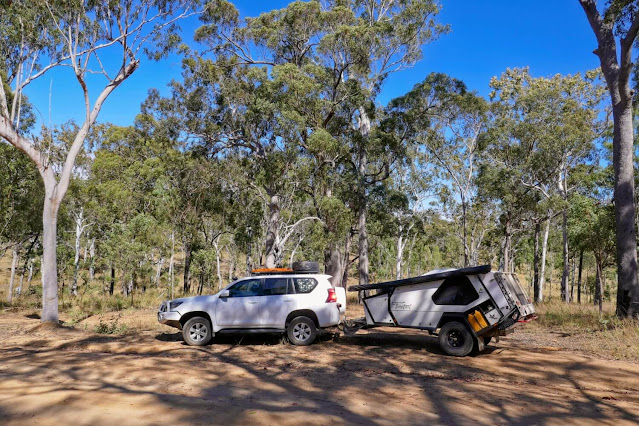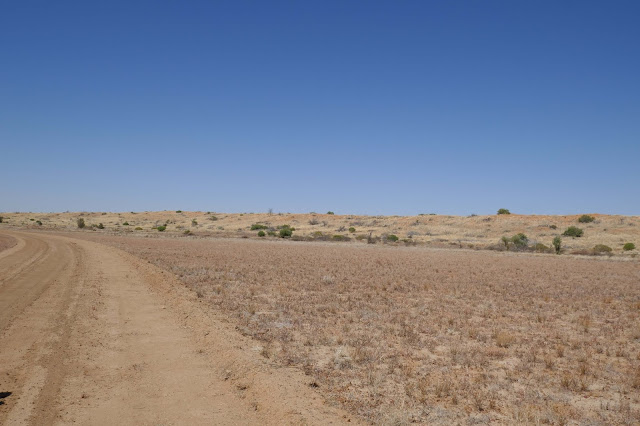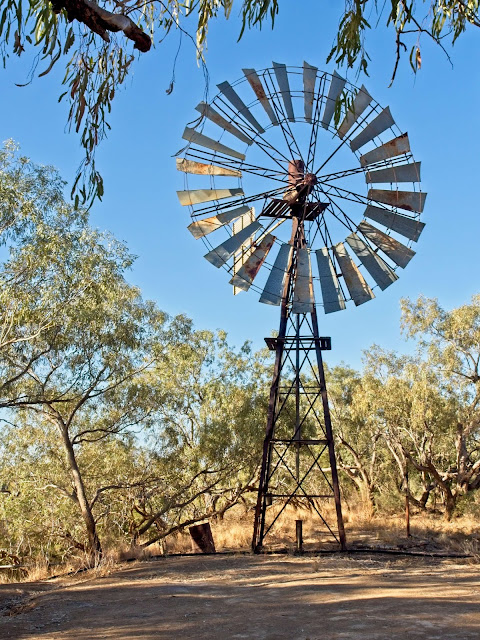Route Travelled
Our departure date was dictated by an invite to a T-Van get-together organised by our selling agents Jason and Mel from Horizon Campers in Townsville. (Those of you who are not familiar with T-vans have a look at Track Trailer for a run down on these excellent camper trailers). This was a thank you to all their customers over the 10 years of running the business.
 |
| Prado and T-Van |
13/8/2020
 |
| Southern Cassowary (photo:- Janet Wood, Lindsay's sister) |
Called into Henrietta Creek in the Wooroonooran National Park for lunch. There is a camping area here but, as it is situated beside the Palmerston Highway, it can be quite noisy due to a lot of heavy goods vehicles coming down off the Atherton Tablelands along this route. There are a few sites away from the road, which would be a bit quieter. Several Wompoo Fruit-Dove were feeding in a fruiting tree beside the highway.
 |
| Wompoo Fruit-Dove |
We continued down the Palmerston Highway turning off before Innisfail to go via South Johnstone and join up with the Bruce Highway south of Innisfail. Our overnight camp was at Murray Falls in the Girramay National Park, north of Cardwell. (Area map here). The 22km road from the highway is mainly bitumen, but turns into a good quality dirt road as you get closer to the camp ground. The camping area features a large, open, grassy camping area with shady trees and several walking tracks. These lead to the bottom and top of the falls. We walked to the top of the falls, where there is a viewing platform overlooking the surrounding area.
 |
| Murray Falls |
Saw a Superb Fruit-dove and Lemon-bellied Flycatcher (Lemon-bellied Fly-eater) along the way.
 |
| Lemon-bellied Flycatcher |
We went for an early morning walk along the bottom of the falls before breakfast and packing up. Drove back to the Bruce Highway along the southern access road, turn right at school, as this is quicker if you are travelling south. Passed through Cardwell and climbed up the range, passing the Hinchinbrook Lookout, worth a visit but we had been before so continued onto Ingham. Fueled up here and met a fellow T-van owner also heading to the get together. Left town on the Mt. Fox road along the Herbert River Valley which was new for us after Trebonne. The area is in the heart of sugar cane growing country and gives great views of the Seaveiw Range which were looming up in front of us. Most of the route is sealed and the road up the range is steep, narrow and winding, luckily for us we did not meet anyone coming down until we reached the top of the range after the road had widened out. The road is not suitable for caravans.
 |
| Mt. Fox Road before steep accent |
 |
| Scaly-breasted Lorikeet |
 | ||
| T-Van Line Up |
 |
| T-Van People |
Various trips were organised along with a communal dinner over the 3 days we were here, we opted out of the trips and did some birding. We revisited Birthday Creek, along the road to Paluma Dam, where we were re-acquainted with the resident Golden Bowerbird, which was busy putting twigs on his maypole bower. He put on a show for over 20 minutes. This was just the beginning of his endeavours to impress a female for mating later in the year, he will decorate the maypole bower with white lichen to complete his masterpiece.
 |
| Golden Bowerbird |
A visit to Paluma Dam was an eye opener due to a few changes since we were last there over 30 years ago! On the way back to Hidden Valley we called into the Grandis Forest and bumped into a couple of birding friends from Townsville. Plenty of Eastern Yellow Robin in the forest.
 |
| Eastern Yellow Robin |
After the get-together we had organised to camp on the nearby Zig-Zag Station, ($30). Our campsite was alongside was the delightful Running River.
 |
| Running River Campsite |
17/8/2020 - 19/8/20
The next morning was a great birding experience, first a White-bellied Sea-Eagle glided over the river to land in a nearby tree, then an Osprey came swooping in to catch a fish before heading downstream.
An Azure Kingfisher was fishing in a rocky section of the river, perching in a tree for some photos, whilst trying to photograph it two more Azure Kingfisher landed a metre away – to close for photos. They took one look at me and flew onto the rocks in the river. Unfortunately I had the wrong settings on the camera so the picture is very average
 |
| Azure Kingfisher |
From here we followed the road from the camp to the Flinders Highway. This is a good wide road with little traffic on it. From here we went along the Hervey Range section of the highway. A good road due to its access to several army training grounds along the way. Once in Townsville we called into ARB to get a replacement fridge power cable as the one on the T-van fridge had been damaged in the fridge-slide. They also had stock of 37lt fridges, which we had tried to buy before we left home, so we bought one to use in the car, good move as it turned out. Had a few nights in the Big
4 Rowes Bay Beach Front Holiday Park as it is conveniently situated next door to our friend Marjory who we were visiting. The next few days were spent picking up a few bits and pieces for our trip and a visit to the Townsville Common, which is usually a great birding location, but not so on this occasion, very quiet in spite of having a lot of water in it for August.
 |
| Lunch at Townsville Common |
20/8/2020
Left Townsville after re-fuelling (diesel $1.08 lt) and headed to Charters Towers and our regular stopping place at Brownson Park for a coffee break. Next stop was a lunch break at the Campaspe River rest stop. After lunch we travelled over the Burra Range to our destination, White Mountains National Park. The park is situated about 80 km north-east of Hughenden and 140 km south-west of Charters Towers on the Flinders Highway. The park covers 12,000 ha with the rugged wilderness featuring spectacular white sandstone bluffs and gorges, and diverse plants and animals. There are 14 ecosystems in the park making it one of Queensland's most botanically diverse with lancewood forests, open woodlands, laterite pastures, heathland and spinifex grasslands as well as sand dunes and sandy flats. Our favourite plant here is Grevillea decora, which has deep red and black flowers and grows to about 4m tall. Unfortunately we were at the end of flowering season with only a few in flower for our visit. The park also contains the headwaters of the Burdekin River and Flinders River plus some water flowing south into the Channel Country and eventually into Lake Eyre. The entrance road to the park is from a rest stop along the Flinders Highway, which has a Telstra Tower overlooking it. From here it is about 10.5km to the Canns Camp Creek camping area, which, when dry it is accessible to all high clearance vehicle types with care. It is accessible for camper trailers but not caravans or buses. The road was in good condition except for a few washouts and corrugations near the camp, not a problem for the T-van. There are 8 camp sites and it is mandatory to book before arriving. Set up camp and had a Southern Boobook calling in the evening.
Awoke to a cold morning of 4ºC. Took a walk along the adjacent dry creek bed and found a few Little Friarbird feeding on the white flowers of Grevillea sessilis, a shrub 2-4m tall.
 |
| Little Friarbird feeding on Grevillea sessilis |
Breakfast was a warming bowl of porridge sprinkled with blueberries and banana to get us going for the day. Drove out of the camp and took the Poison Creek track to Big Swamp passing through open woodland and heathland, where we saw a Common Bronzewing. The track has various surfaces, dirt, rocks and sand with washouts and deep ruts. The swamp was dry with a few drying pools of water, which were attracting a few birds who came in to drink and bathe. Picked one and set up for a morning coffee to see what came in. There were mainly honeyeaters arriving including Blue-faced, Black-chinned, Little and Noisy Friarbird along with Noisy Miner.
 |
| Noisy Miner |
Five Squatter Pigeon (southern sub-species Geophaps scripta scripta), were feeding nearby. This sub-species is listed as threatened mainly due to habitat loss and modification. We continued along the Poison Valley track for a few kilometres until it started to get quite rough and steep and then turned around for the return 20km trip to camp. Afternoon spent around the camp birding.
22/8/2020
Another 4ºC morning and porridge for breakfast with strawberries and banana. Packed up and left camp by 8.30 to join the Burdekin Highway. Drove to Prarie and stopped for a coffee. We had stopped here last time we were out this way and had some good bird sightings. The local bee keeper had planted several grevilleas in his garden, which were attracting many honeyeaters to the nectar rich flowers, look out for the sign!
White-plumed Honeyeater was the most common, but there was also Brown, Singing and Blue-faced Honeyeater plus Little Friarbird. A group of Apostlebird were noisily going about their business, only 6 in this group – not the 12 which gave rise to their name.
 |
| Apostlebird |
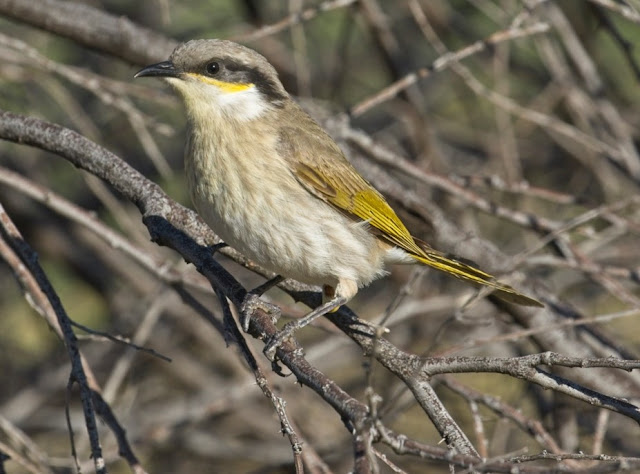 |
| Singing Honeyeater |
Noisy start to the morning due to a few trains passing by, trucks on the highway and a garbage truck collecting the parks rubbish. Drove into town before checking out Chinaman Creek Dam (how long before that name gets changed!), where we found a shady spot on the edge of the dam for lunch. Overlooking the dam we could checkout the waterbirds with the spotting scope, good views of Great-crested Grebe, Black-necked Stork and a few Australian Pelican. We spent sometime looking for a Spotted Bowerbird which was in a tree behind us calling and mimicking other bird species, eventually found it.
 |
| Black-necked Stork |
After lunch drove out to the Cloncurry Wastewater Treatment Plant (-20.6947928,140.5029863). Lots of upgrading works going on, but plenty of birds, which were viewed from behind the perimeter fence. Mainly Grey Teal and Plumed Whistling-Duck, but there were a few Hardhead (duck) and lots of Australasian Grebe. Around the perimeter were a couple of Spinifex Pigeon, some Brolga and a flock of Zebra Finch. Topped up with supplies at the local IGA supermarket.
 |
| Brolga |
25/8/2020
Up at first light to pack up, have showers and off to the Red Door Cafe for breakfast. This cafe is run by a charity organisation to train unemployed people who have barriers to employment. We ordered, our coffees arrived, but after waiting our eggs benedict did not. Our order hadn't reached the chef, but not a problem as we were in no hurry, it was worth the wait. Fortified by a good breakfast we took the Djarra road, which winds its way between spectacular rock formations, spinifex covered hills and open eucalypt woodlands. Passed through Duchess, named after a mine, which was set up after copper was found there in 1897, it now has a population of around 23. Then into Djarra, slightly bigger town which was named after the railway station in 1916. The nearby phosphate mine, (Phosphate Hill) and fertiliser production plant employs some of the locals. Here we joined the Mt. Isa road for a few kilometres and turned off to Cat Dam as it was lunch time. Not very inspiring, but a few birds on the dam, which was heavily impacted by cattle, who were probably the reason it was here in the first place. A White-headed Stilt (Black-winged Stilt) was the most exciting!
 |
| White-headed Stilt (Black-winged Stilt) |
 |
| Little Black Cormorant |
26/8/2020
 |
| Little Corella |
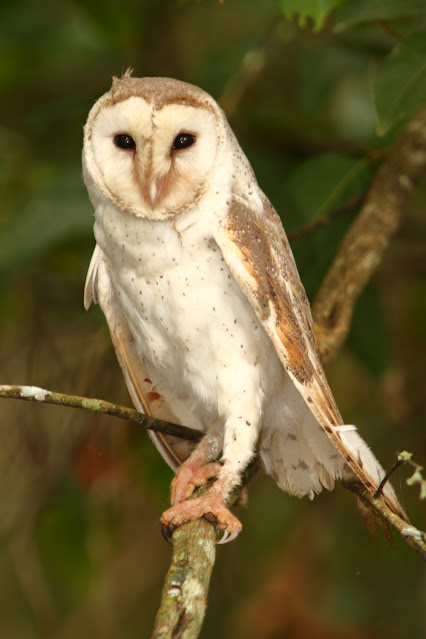 |
| (Eastern) Barn Owl |
A morning walk was very productive with lots of birds including mixed flocks of Masked and Black-faced Woodswallow plus a few White-breasted Woodswallow. A Crested Bellbird was heard, but was unable to track it down and the most prolific honeyeater on the trip, White-plumed Honeyeater, were about in small flocks.
 |
| White-plumed Honeyeater |
 |
| Black-faced Woodswallow |
In town the power lines were crowded with hundreds of Galah, who don’t know how to be quiet, but they were enjoying themselves as usual. On the way back to camp we got bushed with the myriad of tracks in the dark and visited a few camp sites to the surprise of their occupants, eventually found the T-Van.
 |
| Grey-crowned Babbler |
Back in Boulia we visited the Dump Point and filled up the water tank with water provided on the main street via a series of taps conveniently spaced out and marked drinking water. Fueled up at the local garage before turning off onto the Coorabulka Road. Coorabulka Station is located about 99 kilometres south-east of Boulia.
 |
| Coorabulka
Station Road Sign |
The road passes by a few other pastoral stations located in the overgrazed Mitchell Grass plains (not helped by the drought conditions) and a few stands of the Waddie Tree (Acacia peuce). This acacia is classified as endangered and only occurs in three stands in Queensland and the Northern Territory.
 |
| Waddie Tree |
Saw some rare bird activity along the road and stopped for a coffee. Plenty of Zebra Finch, a few Black-faced Woodswallow, a Willie Wagtail and a Black Kite. Continued along the road to Pigeongah Creek, which had a few pools of water in it, but only three species of birds.
 |
| Pigeongah Creek |
Further along the road we came across Six Mile Creek, which had some shade so we stopped for a late lunch. Heard a few Budgerigar and saw a flock of Zebra Finch.
 |
| Zebra Finch - male |
The road continued onto Diamantina National Park where we were greeted by two Emu. Diamantina National Park is 306km from Winton, 183km from Boulia, and 350km from Windorah. Continued onto Hunters Gorge campground, which had most of the sites along the Mundawerra Waterhole taken so we found a quieter spot away from them. We realised that this not very inspiring and very dusty campground was not what we had meant to book. We should have booked Gum Hole campground alongside Whistling Duck Creek, which is set in a shady location, but is unsuitable for caravans. We had a problem with the Prado (our tow vehicle), the back door was jammed and unable to be accessed. That was a job for another day! The lagoon here had a few birds including 21 Australian Pelican.
 |
| Australian Pelican |
29/8/2020
First up got stuck into the door problem. Had to take out the cargo barrier behind the back seats so as to access the rear cargo area – not easy as it was awkward and heavy, but eventually got it out. We have storage draws in the back but as we could not access them had to unscrew the top cover off to get to the contents. After breakfast drove down to the Ranger Station to look at the history display of the property.
 |
| Diamantina Ranger Station |
Then back to the Diamantina River crossing, which is significant to me (Keith) as in 1998 the vehicle I was passenger in drove into the flooded river and we nearly drowned, but for a metal marker post on the low level causeway. This piece of metal got hooked onto the side bar of the vehicle and stopped it rolling over into the downside washout, but there was still only about 600mm of the car above the water line! There is now a higher level bridge across this stretch of river, but I would imagine it still goes under in a flood.
 |
| Diamantina River Crossing Bridge |
From here we went to Gum Hole camp ground for a coffee break, there was enough room to camp with the T-Van, we will know next time! A Spotted Bowerbird came to check us out.
We decided to drive the 85km Warracoota Circuit Drive , which starts at the old steel yards. Steel was used because wooden ones are prone to attack by termites and dry rot. The yards are still used as they are situated on the Springvale Road Stock Route used by drovers moving cattle. The beginning of the road follows a series of red sand dunes, which have been stable for the last 12,000 years. It is an iron coating on the grains of sand, which causes the red colouration of the dunes. From the dunes the track crosses claypans, gibber plains and grasslands. Stopped at Lake Constance and Warracoota Waterhole, neither had good access to the water and not many birds. Had lunch at Warracoota Waterhole before continuing on the loop road back to the main access road. Birdwise it was disappointing with virtually no birds to record, not surprising due to the dry state of the country.
Back at camp there were fewer people camping. The afternoon was one for relaxation watching the pelicans glide by, but we had to wait until 6.30pm for the flies to go away and give us some relief.
 |
| Australian Pelican |
30/8/2020
Up early to survey the lagoon and get organised for the next leg to Winton. This Galah was also up early foraging in a tree alongside the lagoon.
 |
| Galah |
Had breakfast and got on the road by 9.30am. Drove back over the Diamantina Channels and took the Winton road just before the Ranger Station. The road was undulating, rough gravel, big stones and corrugations. After an hour we came across an Artesian Bore with its hot water discharge forming a small water channel along with some ponding, which had attracted a White-necked Heron, two Australian Magpie and two Willie Wagtail. Around the back of the bore were two Pacific Black Duck.
 |
| Artesian Bore along Winton Road |
Had our coffee and continued on to the Old Cork Station waterhole for lunch. Had been here before and remembered it was good for birds so we did a bit of exploring and found a colony of several hundred Corella camped in the trees beside the old creaky 36ft Comet windmill, which is the largest made by Comet Windmills Australia. The fins on the back of windmill say Southern Cross, maybe had a modification in the past?
 |
| Masked Woodswallow |
An early morning walk around the area was very productive. Found three Spinifex Pigeon, 800+ Little Corella who were roosting started flying around along with at least 200 Galah making a lot of noise. A mixed flock of at least 300 Masked and Black-faced Woodswallow were feeding on flowering eucalypt trees.
 | ||
| Spinifex Pigeon |
Checked out the ruins as we walked around.
 |
| Old Cork Station |
 |
| Old Cork Station |
This sign at Old Cork Station is another example targeting inconsiderate campers doing the wrong thing, eventually spoiling it for others.
After breakfast we left about 8.45am to head for Winton. The Cork Mail Road passed by Cork Station before climbing up a nearby escarpment on the Tully Range. At the top is Lawrence Lookout, where we stopped for a spectacular view of the surrounding country and the right time for a morning coffee.
 |
| Lawrence Lookout |
 |
| Lawrence Lookout |
From here we joined the Winton – Jundah Road just north of Lark Quarry (102.5km from Winton). Continued on along the gravel road until 44km from Winton, where it turns into bitumen. Once in Winton we booked into Pelican Fuel Stop and Caravan Park and had a large grassed site. Despite the name they had no fuel when we were here. Started making plans to go to the nearest Toyota dealer, which is in Longreach, to get the rear door fixed. In an inspired moment I checked the rear door handle from underneath and found the smallest of stones lodged under the handle. The smallest screwdriver we had was all that was needed to extract the stone and magically the back door opened – hooray! Not having to go to Longreach meant we could continue heading south instead of east. The rest of the afternoon was spent putting the cargo barrier and fridge back in place.
1/9/2020Early start after a warming coffee to visit the Winton Wastewater Treatment Plant , met two other birders here. Not many birds apart from a few waterbirds such as Australasian Grebe and Grey Teal, plus both Australian Reed Warbler and Little Grassbird.
 |
| Australasian Grebe |
When we were leaving we met some friends from Townsville who we seem to make a habit of bumping into at various locations (the Grandis Forest at Paluma earlier in our trip), so had a chat. One of them was making a video of their travels and insisted on interviewing us! Back for breakfast before going into town to replenish supplies. Tried to get one of our 4Kg gas bottles filled, but no go after visiting four outlets. All had Swap and Go 9Kg bottles too difficult to get employees who have licenses to refill bottles. Afternoon spent getting ready to leave tomorrow. Did have a visit from three Brolga who came wandering around the caravan park!
 |
| Suburban Brolga |
In the evening we walked the short distance into town for a meal at Tattersalls Hotel, had to wait until a table was available, good to see the outback doing well in these tough times.
 |
| Tattersalls Hotel |
2/9/2020
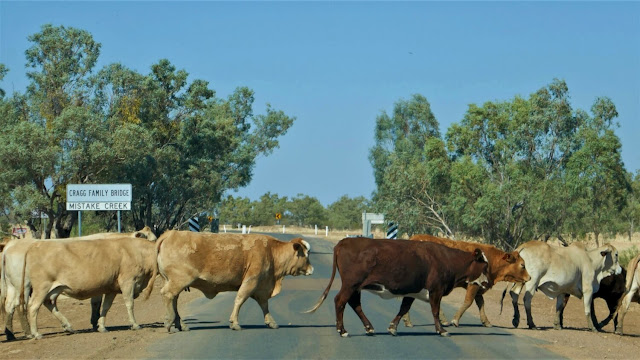 |
| Cattle Rule |
 |
| Eastern Grey Kangaroo |
A Common Bronzewing, White-faced Heron and a few Yellow-throated Miner also came in to forage and drink.
 |
| White-faced Heron |
Checked out the surrounding Spinifex country, where Chestnut-breasted Quail-thrush had been recorded previously, but no sign of any birds here today.
3/9/2020
Slow start to the morning before we headed off stopping at Logan Falls for a morning coffee, very dry here with only a Black-faced Woodswallow seen and a Crested Bellbird heard. Back on the Opalton Road we stopped at Wirribi Bore No 2 where there were a few more birds. These included two Grey Teal, 40+ Little Corella, Raven and 40+ Zebra Finch. Continued on to Opalton Bush Camp, where we found a not so good camp site behind the shower block. Too hot to go birding (37ºC) so we took it easy until the late afternoon when we went out in search of the Opalton Grasswren.
 |
| Grasswren Habitat at Opalton |
This was at least the 5th visit in search of this bird, previously Keith had only had brief glimpses, which was not enough to count it and Lindsay did not even get a glimpse. Once again we tramped around the spinifex seeing a few Spinifex Pigeon and Grey-headed Honeyeater before deciding it was a lost cause again.
 |
| Spinifex Pigeon |
So back to the car to head back to camp when Keith spotted an Opalton Grasswren right beside the car! Lindsay jumped out of the car as it popped out into the open and hopped up onto low branches showing off to us for a few minutes, managed a few photos. Hooray at last!!
 |
| the elusive Opalton Grasswren |
After
all that excitement we returned
to check out the Opalton Dam and a
celebratory dinner. Around
7.00pm we watched the
International Space Station pass by amongst the stars. Well we did have a full moon and here is the space shuttle heading for the station! Just a bit of fun.
4/9/2020
 |
| White-necked Heron |
5/9/2020
 |
| Whistling Kite |
 |
| Brown Treecreeper |
 |
| Red-winged Parrot - male |
Back on the road we headed south along the Jundah Road. Plenty of Wedge-tailed Eagles along this stretch of road including these two perched in a tree a few hundred meters away from their nest.
 |
| Wedge-tailed Eagle |
 |
| Spiny-cheeked Honeyeater |
We were heading for Noonbah Station in the channel country. We left the lookout to continue on to the turnoff to Noonbah Station, where we turned off onto Longreach Road, which crosses the Vergemont Creek channels before Noonbah. Once at Noonbah we were welcomed firstly by Karen and later Angus Emmott, who we have come to know from our previous visits, they always make their guests feel at home. They are both fantastic people who are passionate about the land and the animals present on their property and surrounds. Angus’s knowledge of the local flora and fauna is second to none. Angus has discovery many new species on his property with a number named after him or the family.
 |
| Noonbah Station |
6/9/2020
Early morning walk around the homestead checking out the rusty cars and trucks. Saw a few birds in and around the homestead dam. Drove out to twin dams where the water levels were quite low compared to our visit last year when they were in flood.
 |
| Noonbah Dam |
 |
| Yellow-billed Spoobill |
A couple of Restless Flycatcher were fluttering in front of us and displaying to each other, great entertainment! Galah were also coming in to drink.
 |
| Paperbark Flycatcher |
 |
| Galah |
 |
| Brown Falcon |
7/9/2020
 |
| Old Mail Boat and Mail Truck |
Drove across the Longreach Road to
investigate the national parks campground at
Broadwater Waterhole and took advantage of the shady coolibah trees before returning to camp to organise to leave tomorrow.
8/9/2020
Left Noonbah Station by 8.00am to go to Longreach. Had a Little Eagle fly over the road by Lochern National Park, good start to the morning. The connecting road to the Landsborough Highway is gravel/dirt running through overgrazed sheep country, which has not been helped by the drought. Once on the highway the road is fully sealed to Longreach. First stop after reaching Longreach was the dump point, conveniently located next to the RV/Caravan Parking area, to empty the toilet, essential chore! A pair of Brolga were also here!
 |
| Longreach Brolga |
Walked the short distance into town and found a cafe, which was set up for socially distancing and had a coffee. Then off to the Longreach Waste Water Treatment Plant, where there is a large series of ponds, which had a selection of waterfowl including Hardhead, Grey Teal, Pink-eared Duck, Australasian Grebe and Eurasian Coot. Then back to town to have lunch at the Secret Garden Cafe, quiche and salad, very nice. After lunch we only had 110km to travel to Muttaburra along a dirt/sealed road. We were greeted by a dinosaur made of wire, which was being watched by a kangaroo. Muttaburra is part of the Dinosaur Trail mentioned previously.
 |
| Muttaburra Wire Dinosaur |
The morning started off well with two Collared Sparrowhawk flying around the camp and showing off. This was followed by three White-winged Chough, the only ones of the trip, a few Black-faced Cuckooshrike and a female Rufous Whistler.
 |
| White-winged Chough |
 |
| Black-faced Cuckooshrike |
 |
| Rufous Whistler - female |
 |
| Straw-necked Ibis |
Continued north along the road, which turned into a combination of sealed and gravel stretches. Plenty of roadworks sealing more sections as part of the inland highway to take truck traffic away from the coastal route south along the Bruce Highway. Turned off the highway to go into Blackbraes National Park, 170km north of Hughenden. This is a favourite destination for us and usually call in when heading south. We had the best sighting for our whole trip here, a Park Ranger! The only one we had seen in our visits to several national parks. Had a chat before continuing on to the campsite at Emu Swamp, 20.5km from the park entrance. The access track has numerous raised bumps (whooboys) to slow traffic down and National Parks recommends four-wheel-drive vehicles and camper trailers only. Arrived at the campsite to find nobody else camping and the dam with plenty of water in it. Lots of waterfowl on the dam, plenty Black Swans some in family groups with cygnets in tow. Tawny Frogmouth were calling just on dusk and into the night.
 |
| Blackbraes National Park Camp |
 |
| Tawny Frogmouth |
10/9/2020
 |
| Cattle Truck |
The tyre was also still deflating slowly so we stopped again to put the spare on. Made it to the roadhouse and rewarded ourselves with a coffee and cake. Back on the road we kept heading north passing several water tanks encircled by cattle who had trampled the surrounding ground to dust. The Hughenden road joins the Savannah Way, which heads west to Mt. Surprise, Georgetown and beyond eventually ending up in Broome, Western Australia. Shortly after the junction of these two roads we reached the Forty Mile Scrub National Park in time for lunch. Good spot to stop for a break as there are toilets plus a shelter with tables and benches. Continued on to Mt. Garnet, where we fueled up at the Top Shop Cafe, which consistently has the cheapest fuel in the area. From here we headed to Atherton with an afternoon coffee break at Mt. Hypipamee National Park. Another good place to stop with toilets and tables. By now it was mid-afternoon and within striking distance of home so we kept going until we reached the end of our 4770km journey.
Keith and Lindsay 2020Species List for Trip - Clements and IOC Taxonomies
Taxonomy Clements
Emu
Plumed Whistling-Duck
Black Swan
Muscovy Duck
Cotton Pygmy-Goose
Maned Duck
Pacific Black Duck
Mallard
Grey Teal
Pink-eared Duck
Hardhead
Australian Brushturkey
Orange-footed Scrubfowl
Brown Quail
Australasian Grebe
Great Crested Grebe
Rock Pigeon
White-headed Pigeon
Brown Cuckoo-Dove
Common Bronzewing
Crested Pigeon
Spinifex Pigeon
Squatter Pigeon
Diamond Dove
Peaceful Dove
Bar-shouldered Dove
Wompoo Fruit-Dove
Superb Fruit-Dove
Australian Bustard
Pheasant Coucal
Shining Bronze-Cuckoo
Little Bronze-Cuckoo
Fan-tailed Cuckoo
Tawny Frogmouth
Spotted Nightjar
Australian Owlet-nightjar
Dusky Moorhen
Eurasian Coot
Australasian Swamphen
Baillon's Crake
Brolga
Bush Thick-knee
Pied Stilt
Masked Lapwing
Black-fronted Dotterel
Comb-crested Jacana
White-winged Tern
Whiskered Tern
Black-necked Stork
Australasian Darter
Little Pied Cormorant
Great Cormorant
Little Black Cormorant
Australian Pelican
Pacific Heron
Great Egret
Intermediate Egret
White-faced Heron
Little Egret
Cattle Egret
Rufous Night-Heron
Australian Ibis
Straw-necked Ibis
Royal Spoonbill
Yellow-billed Spoonbill
Osprey
Black-breasted Kite
Pacific Baza
Little Eagle
Wedge-tailed Eagle
Brown Goshawk
Collared Sparrowhawk
Black Kite
Whistling Kite
Brahminy Kite
White-bellied Sea-Eagle
Barn Owl
Barking Owl
Southern Boobook
Azure Kingfisher
Laughing Kookaburra
Blue-winged Kookaburra
Red-backed Kingfisher
Forest Kingfisher
Sacred Kingfisher
Rainbow Bee-eater
Australian Kestrel
Brown Falcon
Black Falcon
Galah
Little Corella
Sulphur-crested Cockatoo
Cockatiel
Australian King-Parrot
Red-winged Parrot
Australian Ringneck
Pale-headed Rosella
Budgerigar
Rainbow Lorikeet
Scaly-breasted Lorikeet
Noisy Pitta
Spotted Catbird
Spotted Bowerbird
Great Bowerbird
Brown Treecreeper
Rusty Grasswren
Red-backed Fairywren
Yellow-spotted Honeyeater
Lewin's Honeyeater
Graceful Honeyeater
Yellow Honeyeater
White-gaped Honeyeater
Yellow-faced Honeyeater
Noisy Miner
Yellow-throated Miner
Bridled Honeyeater
Spiny-cheeked Honeyeater
Singing Honeyeater
White-plumed Honeyeater
Fuscous Honeyeater
Grey-headed Honeyeater
Brown-backed Honeyeater
Rufous-throated Honeyeater
Scarlet Myzomela
Brown Honeyeater
White-cheeked Honeyeater
Blue-faced Honeyeater
White-throated Honeyeater
Black-chinned Honeyeater
Macleay's Honeyeater
Little Friarbird
Helmeted Friarbird
Noisy Friarbird
Red-browed Pardalote
Striated Pardalote
Large-billed Scrubwren
Weebill
Fairy Gerygone
White-throated Gerygone
Brown Gerygone
Grey-crowned Babbler
Hall's Babbler
Barred Cuckooshrike
Black-faced Cuckooshrike
White-bellied Cuckooshrike
White-winged Triller
Varied Triller
Eastern Whipbird
Crested Bellbird
Grey Shrikethrush
Little Shrikethrush
Golden Whistler
Rufous Whistler
Olive-backed Oriole
Australasian Figbird
Yellow-breasted Boatbill
White-breasted Woodswallow
Masked Woodswallow
White-browed Woodswallow
Black-faced Woodswallow
Grey Butcherbird
Pied Butcherbird
Black Butcherbird
Australian Magpie
Pied Currawong
Willie-wagtail
Grey Fantail
Spangled Drongo
Victoria's Riflebird
Magpie-lark
Leaden Flycatcher
Restless Flycatcher
Paperbark Flycatcher
White-winged Chough
Apostlebird
Torresian Crow
Little Crow
Australian Raven
Jacky-winter
Lemon-bellied Flycatcher
Hooded Robin
Eastern Yellow Robin
Grey-headed Robin
Australasian Bushlark
Australian Reed Warbler
Little Grassbird
Welcome Swallow
Fairy Martin
Silvereye
Metallic Starling
Common Myna
Mistletoebird
Zebra Finch
Chestnut-breasted Munia
House Sparrow
Australasian Pipit 198 Species
IOC Taxonomy
Emu
Australian Brushturkey
Orange-footed Scrubfowl
Brown Quail
Plumed Whistling Duck
Black Swan
Pink-eared Duck
Muscovy Duck
Maned Duck
Cotton Pygmy Goose
Pacific Black Duck
Mallard
Grey Teal
Hardhead
Tawny Frogmouth
Spotted Nightjar
Australian Owlet-nightjar
Australian Bustard
Pheasant Coucal
Shining Bronze Cuckoo
Little Bronze Cuckoo
Fan-tailed Cuckoo
Rock Dove
White-headed Pigeon
Brown Cuckoo-Dove
Common Bronzewing
Crested Pigeon
Spinifex Pigeon
Squatter Pigeon
Diamond Dove
Peaceful Dove
Bar-shouldered Dove
Superb Fruit Dove
Dusky Moorhen
Eurasian Coot
Australasian Swamphen
Baillon's Crake
Brolga
Australasian Grebe
Cattle Egret
Rufous Night-Heron
Australian Ibis
Straw-necked Ibis
Royal Spoonbill
Yellow-billed Spoonbill
Osprey
Black-breasted Kite
Pacific Baza
Little Eagle
Wedge-tailed Eagle
Brown Goshawk
Collared Sparrowhawk
Black Kite
Whistling Kite
Brahminy Kite
White-bellied Sea-Eagle
Barn Owl
Barking Owl
Southern Boobook
Azure Kingfisher
Laughing Kookaburra
Blue-winged Kookaburra
Red-backed Kingfisher
Forest Kingfisher
Sacred Kingfisher
Rainbow Bee-eater
Australian Kestrel
Brown Falcon
Black Falcon
Galah
Little Corella
Sulphur-crested Cockatoo
Cockatiel
Australian King-Parrot
Red-winged Parrot
Australian Ringneck
Pale-headed Rosella
Budgerigar
Varied Lorikeet
Rainbow Lorikeet
Scaly-breasted Lorikeet
Noisy Pitta
Spotted Catbird
Spotted Bowerbird
Great Bowerbird
Brown Treecreeper
Rusty Grasswren
Red-backed Fairywre
Lewin's Honeyeater
Graceful Honeyeater
Yellow Honeyeater
White-gaped Honeyeater
Yellow-faced Honeyeater
Noisy Miner
Yellow-throated Miner
Bridled Honeyeater
Spiny-cheeked Honeyeater
Singing Honeyeater
White-plumed Honeyeater
Fuscous Honeyeater
Grey-headed Honeyeater
Brown-backed Honeyeater
Rufous-throated Honeyeater
Scarlet Myzomela
Brown Honeyeater
White-cheeked Honeyeater
Blue-faced Honeyeater
White-throated Honeyeater
Black-chinned Honeyeater
Macleay's Honeyeater
Little Friarbird
Helmeted Friarbird
Noisy Friarbird
Red-browed Pardalote
Striated Pardalote
Large-billed Scrubwren
Weebill
Fairy Gerygone
White-throated Gerygone
Brown Gerygone
Grey-crowned Babbler
Hall's Babbler
Barred Cuckooshrike
Black-faced Cuckooshrike
White-bellied Cuckooshrike
White-winged Triller
Varied Triller
Eastern Whipbird
Crested Bellbird
Grey Shrikethrush
Little Shrikethrush
Golden Whistler
Rufous Whistler
Olive-backed Oriole
Australasian Figbird
Yellow-breasted Boatbill
White-breasted Woodswallow
Masked Woodswallow
White-browed Woodswallow
Black-faced Woodswallow
Grey Butcherbird
Pied Butcherbird
Black Butcherbird
Australian Magpie
Pied Currawong
Willie-wagtail
Grey Fantail
Spangled Drongo
Victoria's Riflebird
Magpie-lark
Leaden Flycatcher
Restless Flycatcher
Paperbark Flycatcher
White-winged Chough
Apostlebird
Torresian Crow
Little Crow
Australian Raven
Jacky-winter
Lemon-bellied Flycatcher
Hooded Robin
Eastern Yellow Robin
Grey-headed Robin
Australasian Bushlark
Australian Reed Warbler
Little Grassbird
Welcome Swallow
Fairy Martin
Silvereye
Metallic Starling
Common Myna
Mistletoebird
Zebra Finch
Chestnut-breasted Munia
House Sparrow
Australasian Pipit 198 Species

